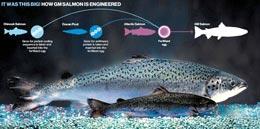Transgenic salmon, anyone?

A genetically modified salmon created by Singapore scientist Hew Choy Leong more than 20 years ago in Canada looks set to be the world's first GM animal to hit dinner plates.
The transgenic Atlantic salmon - inserted with genes from the Chinook salmon and ocean pout so it can grow twice as fast - is safe to eat and will not harm the environment, the United States Food and Drug Administration (FDA) has decided after lengthy evaluations, said a report in Asiaone.
A final hurdle remains: a public consultation process on the environmental assessment. But industry players say it is almost a foregone conclusion that the FDA will give the final nod after the deadline for voicing concerns is up at the end of this month.
Most countries take the lead from the powerful watchdog agency, so a "yes" by the FDA would open the doors to the world market, said Professor Hew.
And farms in the United States and China have already indicated interest in breeding the fish.
The approval will bring no great riches to the 70-year-old emeritus professor at the National University of Singapore's (NUS) Department of Biological Sciences, who created the fish while doing research in Canada.
The pending decision by the FDA comes some 17 years after the company behind the fish - AquaBounty Technologies in Boston - applied to produce the fish commercially.
Prof Hew left the company he formed in 1999 to focus on his duties at NUS, although he still has a small number of shares. There will also be no royalties from his patent as it runs out this year.
"If you're looking for fast returns, this was definitely not the venture to be in," he said. "But as a scientist, looking back I have no regrets. This technology can contribute to solving food shortages given the increasing world population."
He has eaten the fish himself many times, and said that detractors who call GM salmon a "Frankenfish" are missing the science.
"The science is solid and the FDA has made its decision based on science," he said.
The fish has been judged as having no biological differences from regular Atlantic salmon, and is just as safe to eat.
The US National Marine Fisheries and the Fish and Wildlife Service have come to the same conclusion as the FDA - that the fish do not present an environmental danger, he noted.
Anti-GM groups, however, are dead set against it.
British-based GM Freeze, for instance, said that the FDA decision was based on "wholly inadequate safety data" and that the environmental impact could be considerable.
To prevent GM fish from escaping and spawning in the wild, however, they are bred in inland facilities, and the fish produced are female and sterile.
Many scientists have also endorsed the fish - the AquAdvantage salmon - and say the technology behind it is a way of easing the world's food burden.
One group of researchers, developers and investors feel so strongly about the bureaucratic bottlenecks that they petitioned US President Barack Obama last year.
"Any further unexplained delay in moving forward with the regulatory process of this precedent-setting case diminishes existing and future investment and innovation across the entire range of agriculturally important animals," they said.
"Animal biotechnologies have the potential to help address the challenges of food security at a time when the US and the other countries of the world could greatly benefit from such innovation."
The fast-growing Atlantic salmon is modified to carry a growth hormone gene from the Pacific Chinook salmon.
It is also given an anti-freeze gene promoter from the ocean pout - an eel-like cold-water fish - which keeps the hormone active all the time.
This hormone is usually produced only some of the time, in response to environmental cues such as temperature, the length of the day, and other endocrine controls.
As a result, instead of taking about three years to reach the market weight of between 4kg and 5kg like ordinary Atlantic salmon, transgenic salmon can do so in just 18 months.
Leave a comment









